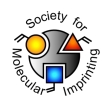Authors: Liu MX, Sun Y, Na SB, Yan F
Article Title: Selective adsorption of lead(II) from aqueous solution by ion-imprinted PEI-functionalized silica sorbent: studies on equilibrium isotherm, kinetics, and thermodynamics.
Publication date: 2015
Journal: Desalination and Water Treatment
Page numbers: 1-13.
DOI: 10.1080/19443994.2014.984342
Abstract: A new ion-imprinted poly(ethyleneimine)(PEI)-functionalized silica sorbents were synthesized by a hydrothermal-assisted surface grafting technique with Pb(II) as the template, PEI as the functional molecular, and epichlorohydrin as the cross-linking agent for the selective adsorption of Pb(II) from aqueous solution, and was characterized by FTIR, SEM, TGA-DTA, nitrogen adsorption, and the static batch experiment. Static adsorption experiment results showed that Pb(II)-imprinted PEI-functionalized silica sorbents had high static adsorption capacity of 60.4 mg g-1, reached an equilibrium state within 20 min, displayed stable adsorption ability for Pb(II) ions in the range of pH 4.8, had satisfactory selectivity toward Pb(II) and could be used repeatedly. Compared with Freundlich and Dubinin-Radushkevich isotherms, equilibrium data fitted to Langmuir adsorption model. The kinetic process of adsorption followed a pseudo-second-order model compared to pseudo-first-order, Elovich and intraparticle diffusion models. Negative values of Δ G° indicated spontaneous adsorption and the degree of spontaneity of the reaction increased with increasing temperature. Positive values of Δ H° showed that the adsorption process was endothermic in the experimental temperature range. The results indicated that Pb(II)-imprinted PEI-functionalized silica sorbents could be employed as an effective material for the selective adsorption of Pb(II) ions from aqueous solutions
Author keywords: Pb(II), Poly(ethyleneimine), Ion-imprinted polymer, Hydrothermal-Assisted, Adsorption



Join the Society for Molecular Imprinting

New items RSS feed
Sign-up for e-mail updates:
Choose between receiving an occasional newsletter or more frequent e-mail alerts.
Click here to go to the sign-up page.
Is your name elemental or peptidic? Enter your name and find out by clicking either of the buttons below!
Other products you may like:
 MIPdatabase
MIPdatabase









